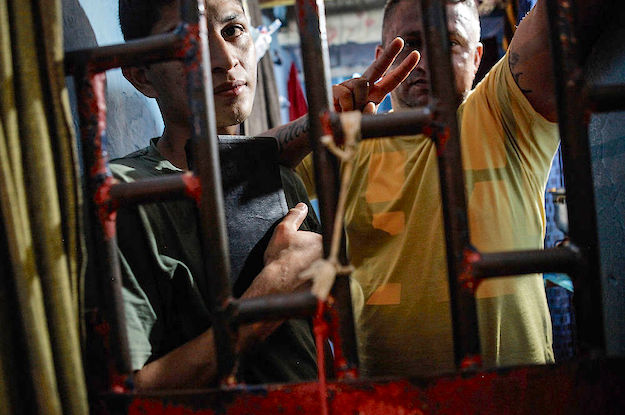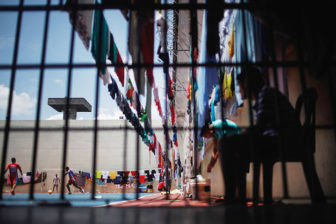RIO DE JANEIRO – Brazil has struggled to contain prison violence for decades. A riot at the Altamira prison in Pará state on July 29, which left at least 62 inmates dead, revealed just how much work still needs to be done.
Fixing Brazil’s dysfunctional prison system is a complex challenge, tied to the social fabric of the country itself. Yet both short- and long-term solutions do exist. Here’s a look at the root causes of Brazil’s prison violence, how the current government is approaching the problem, and what can be done to turn the tide.
What is driving prison violence in Brazil?
Brazil has the third largest prison population on the planet after the U.S. and China. According to the National Justice Council (CNJ), it registers as many as 812,000 incarcerated people in state prisons, while there is officially space for fewer than 418,000. The prison population is also growing fast – about a three-fold increase since 2000. There are multiple reasons why Brazil is home to the most violent prisons in the world. One of them is that its corrections facilities are severely overcrowded and subject inmates to inhumane conditions.
Take the case of the prison facility in Altamira, where this week’s massacre of occurred: it had 343 detainees crammed into a space designed for just 163. This was a tragedy foretold. A CNJ report published the same day as the Altamira killings described conditions in the prison as “terrible,” observing that it had just 33 guards and woefully inadequate cell space. The same prison also suffered from riots that killed eight inmates in September 2018. The situation is hardly better elsewhere in the state, where prisons are about 8,600 detainees over-capacity.
Another reason why Brazil’s state prisons experience brutal riots so often is inter-factional violence between drug trafficking organizations. State authorities have effectively relinquished control of prisons to criminal factions that now act as de facto judges, jurors and executioners. Rival gangs have divided up the facilities and actively recruit new members in exchange for protection and welfare support for their families. When prison riots break out, as they frequently do, under-resourced and under-staffed authorities can do little more than contain the violence, intervening only after the worst of it is over.
Dramatic overcrowding and the dominance of drug trafficking groups make Brazil’s more than 1,500 state prisons exceedingly dangerous. The homicide rate in state prisons is several times the national average (in contrast to the country’s five high-security federal facilities). Torture and sexual violence are also common. For example, detainees are 30 times more likely to contract tuberculosis and almost 138 times more likely to be infected with H.I.V. than the average Brazilian. A former justice minister, José Eduardo Cardozo, described Brazil’s prisons as “medieval,” saying he’d rather die than spend a day in one.
Why can’t the state prevent prison violence?
The prison violence in Altamira was horrendous, but not unprecedented. This is the fifth major prison riot in Brazil since 2017. It is also the most violent since the 1992 massacre of 111 inmates in São Paulo’s Carandiru prison – a riot that spawned the country’s most powerful drug trafficking organization, the First Capital Command (PCC). Outbreaks of prison violence also occurred in Rondônia in 2002, Maranhão in 2010, Pernambuco in 2011, Rio de Janeiro in 2014 and Roraima, Rio Grande do Norte and Amazonas between 2017 and 2019. Most Brazilian states have suffered from prison violence over the last 10 years.
The national government has struggled to regain control of the penal system. In recent years, it has deployed the armed forces to end hostage situations and occupy prisons. Following a series of prison riots that killed over 120 people in January 2017, the administration of then-President Michel Temer requested that the military intervene and conduct spot searches for firearms, knives, mobile phones, drugs and other contraband. Likewise, national and state authorities routinely set up commissions and task forces to issue recommendations on how to clamp down on violence. But for the most part these interventions have been sporadic, and have done very little to curb the problem.
One reason why making real progress has been so difficult is that Brazil’s prisons mirror deeper structural injustices in society as a whole. The country’s penal system is fundamentally unequal. For example, inmates who have a university degree – such as politicians and company bosses charged with a white-collar crime – have their own cells and decent living conditions. By contrast, less-educated detainees – including non-violent and first-time drug offenders – are crammed into tiny cells cheek by jowl with violent criminals. They rarely can afford a public defender, if one is available at all. As a result, young black males from low-income neighborhoods are the most likely to die while languishing in custody.
The risks of prison violence are exacerbated by a lack of opportunities for inmates once they’ve entered the penal system. Few prisoners have any access to employment, for example. As of June 2017, the last year for which records are available, just 17,5% of all prisoners were working. Similarly, just 10.6% of all inmates were continuing their education, despite this being a right enshrined in law. Creative programs to provide prisoners with job skills and economic opportunities, like a cooperative at the Tremembé women’s prison in São Paulo state sponsored by the NGO Humanitas360, have run into opposition from politicians wary of being seen as soft on criminals – Governor João Doria’s administration discontinued the program in May.
The result is that the majority of those people incarcerated in Brazil today have virtually nothing to do with their time while in prison, and are unprepared to reintegrate into society when they leave. Making matters worse, there are very few services available for those who make it out. Despite earning international accolades for its rehabilitation work over the past four decades, the Association for the Protection and Assistance to the Convicted (APAC) has struggled to scale up its activities.
What is the government’s position on mass incarceration?
President Jair Bolsonaro’s administration is intent on expanding the prison population as part of its anti-crime agenda. The president campaigned with a pledge to crack down on violent crime using the familiar refrain that “a good criminal is a dead criminal.” He vowed to “stuff prison cells with criminals” and said he’d “rather have a prison cell full of criminals than a cemetery full of innocent people.” He has repeated these kinds of statements several times since being elected, calling for more repressive policing, stiffer sentencing and separating gang leaders from the rank-and-file.
At the center of the national government’s strategy are measures to lengthen and strengthen sentencing, especially for violent crime. The president has adopted an especially hard line, calling for the end of custody hearings. Justice Minister Sérgio Moro, while committed to hardening sentencing legislation and restricting the rights of detainees, appears to be more hesitant about the risk of overloading the prison system with more inmates. Moro is on record, however, saying that faction leaders should stay in federal prisons “forever.”
The tone set by the federal government resonates with many Brazilians who are increasingly numb to prison massacres. Brazil is the world’s most homicidal country, and 59% of Brazilians report fear of becoming a homicide victim. The “tough on crime” message is appealing to voters, many of whom agree that criminals should be stripped of their rights (and, if necessary, their lives). And while there are innovative strategies underway at the state level to prevent criminal violence generally, these are hard to distill into rousing sound bites and do not receive widespread attention from policymakers or the general public.
What measures are the national authorities taking to stop prison violence?
To date, the national government’s efforts have focused on separating the leaders of drug trafficking organizations from the rank-and-file. This includes transferring the most violent inmates (including those involved in recent riots in Altamira) from state to federal facilities. In February this year, for example, 22 PCC leaders were transferred from a state facility in São Paulo to a federal prison. And in May, 11 PCC leaders were transferred to a federal penitentiary in Rio Grande de Norte. This week, another 46 inmates suspected of involvement in the Altamira massacre were sent to a federal prison in Pará. Four of them were murdered while being transferred to the neighboring city of Belem.
The national authorities have also undertaken a series of emergency measures in response to the latest massacre at Altamira. First, Moro called an emergency meeting – announcing both the transfer of prisoners and the ramping-up of military presence near high-risk penitentiaries. The government also created a penitentiary intervention task force (FTIP) that will be deployed to Pará for 30 days. The FTIP will focus on coordinating security, surveillance and custodial duties, as well as logistical and supervisory support for the authorities. In addition to pledging to build five new prisons to hold up to 2,000 more inmates, the state’s governor, Hélder Barbalho, has said that at least 1,000 new security agents will patrol existing facilities.
In the medium term, the national authorities recently announced that they would build the equivalent of 20,000 new cell spaces in state prisons by the end of 2019. They intend to do this with some 1.1 billion reais (about $285 million) of funding from the National Penitentiary Fund (FUNPEN). DEPEN, the national penitentiary department, has said that there is a shortfall of at least 300,000 spaces, though this is likely an undercount. Moro is convinced that investment in prison building and penal reform is key to regaining control over facilities and deterring crime.
DEPEN has also offered proposals to try to tamp down prison violence. For example, in addition to building spaces for new inmates, it has also established two task forces, one to expand access to public defenders and another to strengthen security and custody conditions in two badly affected states, Amazonas and Roraima. The National Commission on Justice has also launched a new project – Justiça Presente– to improve record keeping and reduce recidivism. These proposals are long on ambition, but still thin on practical details.
How will national anti-crime measures affect prison populations?
The current government has yet to put forward a comprehensive national public security plan. Instead, there is a “package” of separate projects currently under congressional review. Among them are Moro’s anti-crime and anti-corruption strategies, which include changes to 14 laws and 70 separate measures. Another project was developed by a special commission led by the former justice minister and current Supreme Court justice, Alexandre de Moraes. While some of the proposed measures could make a positive difference – notably investments in criminal investigation, improvements in data collection and management, and the creation of an advanced intelligence system – some others could profoundly deepen the country’s prison crisis.
One of the most controversial is a proposal that stiffens sentences for drug-related offences. Specifically, any “association with drug trafficking” would be treated as a “heinous crime,” equivalent to murder. At the moment, roughly 29% of the male prison population and 64% of the female prison population are jailed for drug-related offences, including for minor possession and consumption. Ratcheting-up sentencing for these kinds of offenses will expand Brazil’s prison population and further undermine young people’s opportunities. Roughly 54% of the prison population are males between 18 and 29 years with limited education and weak social support structures. The prospects for rehabilitating these young men will diminish even further if their sentences are prolonged.
Another contentious proposal calls for increasing civilian and police discretion in the use of lethal force for self-defense. The current administration advocates broadening the right of law enforcement and citizens to use lethal force in contexts where they may experience “extreme emotion” and “imminent risk.” There is an enormous level of subjectivity and ambiguity about what this means in practice. The proposal, combined with the dramatic deregulation of firearms legislation, is potentially dangerous in a country as polarized as Brazil.
As for drug policy more generally, there are few signs of any meaningful reform on the horizon. The new National Drug Policy was drafted by conservative lawmakers and published in April 2019. Not surprisingly, it advocates abstinence. Congress also recently passed a bill that increases penalties for drug traffickers and requires users to be treated by private and religious rehabilitation services. None of this comes as much surprise. The Bolsonaro administration came to power advocating a tough line on drugs both at home and abroad.
Taken together, these anti-crime projects will almost certainly increase the time people spend behind bars, especially recidivists. They could also contribute to an increase in the excessive use of police force – indeed, these tendencies are already evident as police killings across the country are rising in 2019 compared to 2018. An underlying assumption of the national and state authorities is that a “tough on crime” criminal justice and penal posture will deter future crime. But there is little consensus about whether such strategies actually work in practice to prevent and reduce crime.
What should the government do?
The truth is that Brazilian policymakers have long responded to the prison crisis by building more prisons, increasing penalties, and separating gang leaders from the rank-and-file. There is less focus on pursuing alternatives to prison for first-time, non-violent offenders or reducing the country’s recidivism rates. Indeed, since 2018, close to 9,000 prison spaces were built in the country – but the number of new inmates jumped by more than 17,800 over the same period. Filling Brazilian jails is not only costly and demonstrably ineffective at reducing violence, it is strengthening the hand of organized crime.
The most effective way to reduce prison violence is by reducing both the stock and flow of people in prisons. This will require dramatically reducing the number of inmates who are experiencing pre-trial detention. One way to do this is by incentivizing federal and state-level judges, prosecutors and public defenders to resolve outstanding cases and penalizing those who do not. Also needed is a realistic plan to fix Brazil’s deplorable juvenile justice system. State and municipal authorities must also assume a greater responsibility when it comes to taking back control of their prisons and improving conditions within them. Keeping young people in schools is no less important, since this can help reduce the chance of their joining organized crime groups later in life.
The government will not diminish prison violence by imposing iron-fisted laws or building new prisons. While legal reforms are clearly needed, greater enforcement legislation — including ensuring that suspects are provided hearings within 24 hours of their arrest and dramatically expanding access to public defenders – is required. And much greater investment is needed to rehabilitate inmates, especially first-time non-violent offenders. About 70% of Brazilian detainees end up back in jail within five years.
In the long term, bold reforms are needed to update drug policy, rehabilitate inmates, and work with communities affected by organized crime. Unfortunately, progressive legislation on these issues has stalled in Brazil’s Supreme Court. If the flow of new inmates is to be stemmed, federal and state level judges, prosecutors and public defenders need support to resolve outstanding cases and innovative integration programs must be improved and scaled-up. Sadly, the chances of any of this happening under the current government are slim.
—
Muggah is the co-founder of the Igarapé Institute and the SecDev Group and Foundation. Taboada and Tinoco are researchers at the Igarapé Institute.








